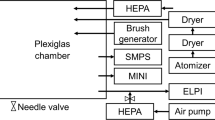Abstract
Spectrothermography, defined as the evaluation of thermograms of carbon evolved from heated aerosol samples, is a technique for evaluating differences in particle characteristics as they relate to emission sources and processes that modify particle evolution. Here we describe the inherent uncertainties and demonstrate the utility of this technique with an evaluation of samples that were collected with eight stage cascade impactors at three sites in Mexico City over a period of 5 months. The study was implemented with statistical analysis based on tests for goodness of fit to separate thermograms with distinctive shapes related to the relative amounts of organic and elemental carbon mass that evolves as a function of temperature. Thermograms with unique shapes were found for particles with aerodynamic diameters of 1–10, 0.56–1, 0.32–0.56 and 0.18–0.32 μm with further differentiation of curves related to the relative amounts of gasoline and diesel fuel that was combusted in the region of the three sites. The common shapes fit 32–42% of samples in each particle size range and indicate that this type of analysis can help distinguish differences in the primary sources of organic and elemental carbon.






Similar content being viewed by others
Notes
A type I error is when a hypothesis is proved false when it is actually is true. A type II error when the hypothesis is incorrectly accepted.
References
Bevington, P.R., Robinson, D.K.: Data reduction and error analysis for the physical sciences, 3rd ed., pp. 320. McGraw-Hill, New York (1993)
Chow, J.C., Watson, J.G., Pritchett, L.C., Pierson, W.R., Frazier, C.A., Purcell, R.G.: The DRI thermal/optical reflectance carbon analysis system: description, evaluation and applications in US air quality studies. Atmos. Environ. 27A(8), 1185–1201 (1993)
Dockery, D.W., Pope, C.A., Xu, X., Spengler, J.D., Ware, J.H., Fay, M.E., Ferris, B.G., Speizer, F.E.: An association between air pollution and mortality in six US cities. N. Engl. J. Med. 329, 1753–1808 (1993)
Ellis, E., Novakov, T.: Application of thermal analysis to the characterization of organic aerosol particles. Sci. Total Environ. 23, 227–238 (1982)
Ellis, E., Novakov, T., Zeldinc, M.D.: Thermal characterization of organic aerosols. Sci. Total Environ. 36, 261–270 (1984)
Gàl, S., Paulik, F., Pell, E., Puxbaum, H.: Thermoanalytical investigations on dust. Fresenius Z. Anal. Chem. 282, 291–295 (1976)
Haines, P.: Thermal methods of analysis, p. 283. Blackie Academic & Professional, Glasgow (1995)
Hamilton, R.S., Mansfield, T.A.: Airborne particulate elemental carbon, its sources, transport, contribution to dark smoke and soiling. Atmos. Environ. 25, 715–723 (1999)
Huebert, B, Charlson, R.: Uncertainties in data on organic aerosols. Tellus 52B, 1249–1255 (2000)
International Union of Pure and Applied Chemistry (IUPAC): Compendium of chemical terminology, 2nd ed. http://www.chemsoc.org/chembytes/goldbook/ (1997)
Jacobson, M.Z.: Strong radiative heating due to the mixing state of black carbon in atmospheric aerosols. Nature 409, 695–697 (2001)
Marple, V.A., Rubow, K.L., Behm, S.M.: A microorifice uniform deposit impactor (MOUI): description, calibration, and use. Aerosol Sci. Tech. 14, 434–446 (1991)
Meier, P., Zünd, R.: Statistical methods in analytical chemistry, 1st ed., p. 417. Wiley Interscience, Hoboken, NJ (2000)
Muhlbaier, P.K., Williams, R.L.: Fireplaces, furnaces and vehicles as emission sources of particulate carbons. In: Wolff, G.T., Klimsch, R. (eds.) Particulate carbon: atmospheric life cycle, pp. 185–205. Plenum, New York (1982)
Muhlbaier, P.K., Cadle, S.H.: Atmospheric carbon particles in Detroit urban area: wintertime sources and sinks. Aerosol Sci. Technol. 10, 237–248 (1989)
National Institute of Standards and Technology (NIST): Certificate of analysis, SRM 1649a urban dust. National Institute of Standards and Technology, Gaithersburg, MD (2001)
Novakov, T., Corrigan, C.: Thermal characterization of biomass smoke particles. Mikrochim. Acta 119, 157–166 (1995)
PROAIRE: Programa para mejorar la calidad del aire en el valle de México: 1995–2000, 1st ed., p. 244. Departamento del Distrito Federal, Gobierno del Estado México, Secretaría de Medio Ambiente, Recursos Naturales y Pesca y Secretaria de Salud, Mexico (1997)
Puxbaum, H.: Application of two thermo-gas analyzers for atmospheric aerosol characterization. Int. J. Environ. Anal. Chem. 10, 1–6 (1981)
Schauer, J.J., Kleeman, M.J., Cass, G.R., Simoneit, B.R.: Measurement of emissions from air pollution sources. 1. C1 through C29 organic compounds from meat charbroiling. Environ. Sci. Technol. 33, 1578–1587 (1999)
Schmid, H., Laskus, L., Abraham H.J., Baltensperger, U., Lavanchy, V., Bizjak, M., Burba, P., Cachier, H., Crow, D., Chow, J., Gnauk, T., Even, A., ten Brink, H.M., Giesen, K.P., Hitzenberger, R., Hueglin, C., Maenhaut, W., Pio, C., Carvalho, A., Putaud, J.P., Toom-Sauntry, D., Puxbaum, H.: Results of the “carbon conference” international aerosol carbon round robin test stage I. Atmos. Environ. 135, 2111–2121 (2001)
Turpin, B.J., Huntzicker, J.J., Hering, S.V.: Investigation of organic aerosol sampling artifacts in the Los Angeles basin. Atmos. Environ. 28(19), 3061–3071 (1994)
Turpin B.J., Saxena, P., Andrews, E.: Measuring and simulating particulate organics in the atmosphere: problems and prospects. Atmos. Environ. 34(18), 2983–3013 (2000)
Viidanoja, J., Kerminen, V.M., Hillamo, R.: Measuring the size distribution of atmospheric organic and black carbon using impactor sampling coupled with thermal carbon analysis: method development and uncertainties. Aerosol Sci. Tech. 36, 607–616 (2002)
Watson, J.G., Chow, J.C., Pritchett, L.C., Houck, J.A., Ragazzi, R.A., Burns, S.: Chemical source profiles for particulate motor vehicle exhaust under cold and high altitude operating conditions. Sci. Total Environ. 93, 183–190 (1990)
Acknowledgments
The authors thank the Centro de Salud Luis Ruiz, ENEP Iztacala and the CCA authorities for making available their facilities, to Omar Velazquez and Orlando Ugalde for technical support during the field campaign and to María Isabel Saavedra for her help with gravimetric and spectrothermographic analyses. This project was supported by funding from the US–Mexico Foundation for Science (FUMEC) and the MIT-CAM project (Fideicomiso Ambiental del Valle de México).
Author information
Authors and Affiliations
Corresponding author
Rights and permissions
About this article
Cite this article
Peralta, O., Baumgardner, D. & Raga, G.B. Spectrothermography of carbonaceous particles. J Atmos Chem 57, 153–169 (2007). https://doi.org/10.1007/s10874-007-9070-1
Received:
Accepted:
Published:
Issue Date:
DOI: https://doi.org/10.1007/s10874-007-9070-1




